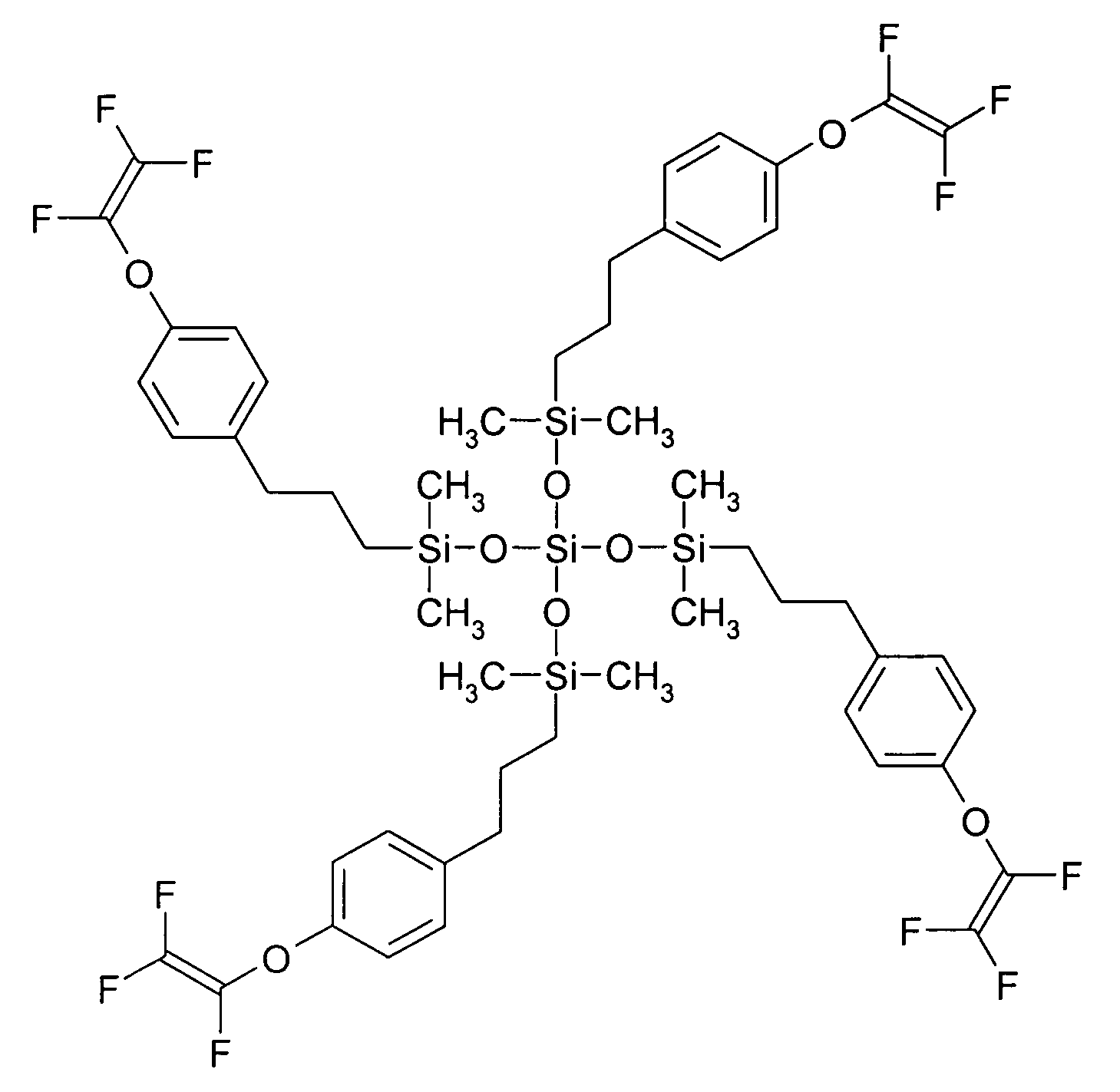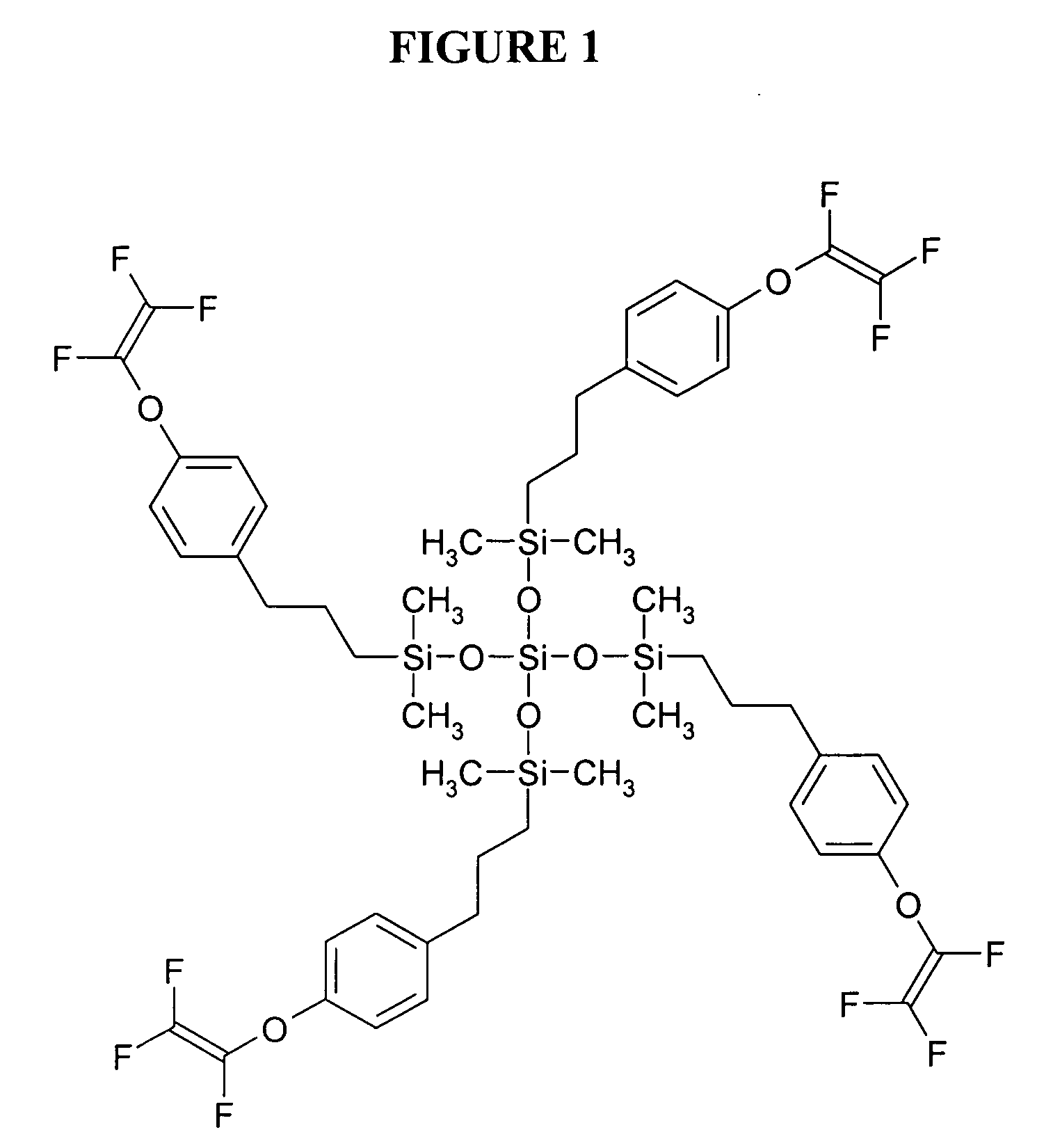Biomedical devices
a biomedical device and device technology, applied in the field of biomedical devices, can solve the problems of inability to wear comfortably in the eye, difficulty in and/or expensive synthetic routes, and inability to meet the needs of patients,
- Summary
- Abstract
- Description
- Claims
- Application Information
AI Technical Summary
Benefits of technology
Problems solved by technology
Method used
Image
Examples
example 1
[0058] This example illustrates the preparation of a 3-(4-[trifluorovinyloxy]phenyl)propyl terminated poly(dimethylsiloxane) having a number average molecular weight (Mn) of 1523 and a polydispersity (PD) of 1.35 (as determined using SEC and by comparison to standards of known molecular weight) and of the formula
wherein n is an average of 8.
[0059] To a solution of hydride terminated poly(dimethylsiloxane) obtained from Aldrich Chemical Co. (Milwaukee, Wis.) (average Mn 580 g / mol, 3.47 g) and 4-(trifluorovinyloxy)allylbenzene (3.87 g, 17.9 mmol) prepared from 1-bromo-4-(trifluorovinyloxy)benzene obtained from Oakwood Products, Inc. (West Columbia, S.C.) using procedures set forth in the literature (e.g., Polymer Preprints, 39(1), p. 530 (1998)) in tetrahydrofuran / 1,4-dioxane (2:1 v / v, 36 mL) was added 10% solution of platinum-1,3-divinyl-1,1,3,3-tetramethyldisiloxane complex in xylenes (0.01 mL) and the solution was heated 15 hours at 60° C. The solvents were removed from the coo...
examples 2-6
[0060] Various proportions of 3-(4-[trifluorovinyloxy]phenyl)propyl terminated poly(dimethylsiloxane) (T2D8) of Example 1 and 1,1,1-tris(4-[trifluorovinyloxy]phenyl)ethane (T3) (crosslinker) obtained from Oakwood Products, Inc., (West Columbia, S.C.) were dissolved with gentle heating and stirring and each of the warm solutions was clamped between silanized glass plates with a Teflon tape spacer. Each of the glass plates containing the solution was heated for 20 hours at 195° C. under a nitrogen atmosphere. The cooled, transparent materials ranged from an organic soluble (i.e., dichloromethane), viscous oil (0% T3) to a brittle, insoluble film (100% T3). The properties of the polymers of examples 2-6 were determined to demonstrate modified mechanical properties as a function of crosslinking density. These results are set forth below in Table 1.
TABLE 1Example23456T2D8 / T3 (w / w)0 / 100a25 / 7550 / 5075 / 25b100 / 0cModulus (g / mm2)—4962(211)3692(85) ——Elongation (%)—66(7)72(2)——Tensile Strength...
examples 7-9
Poly(perfluorocyclobutane) with 4-(trifluorovinyloxy)benzoic acid as Wetting Agent
[0061] Various proportions of 4-(trifluorovinyloxy)benzoic acid (TA) prepared from 1-bromo-4-(trifluorovinyloxy)benzene obtained from Oakwood Products, Inc. (West Columbia, S.C.) using procedures set forth in the literature (e.g., Polymer Preprints, 43(1), p. 487 (2002)), 3-(4-[trifluorovinyloxy]phenyl)propyl terminated poly(dimethylsiloxane) (T2D8) of Example 1 and 1,1,1-(4-[trifluorovinyloxy]phenyl)ethane (T3) were dissolved with stirring and gentle heat. The weight ratio of T2D8 to T3 was held constant at 50:50 for all samples and the amount of TA was varied. The warm solution was clamped between silanized glass plates using Teflon tape spacer and heated under a nitrogen atmosphere at approximately 195° C. for 20 hours. The cooled, transparent, tack-free films were removed from the glass plates and further analyzed. Equilibrium water uptake was measured by measuring mass increase of film after soak...
PUM
| Property | Measurement | Unit |
|---|---|---|
| temperatures | aaaaa | aaaaa |
| temperatures | aaaaa | aaaaa |
| temperatures | aaaaa | aaaaa |
Abstract
Description
Claims
Application Information
 Login to View More
Login to View More - R&D
- Intellectual Property
- Life Sciences
- Materials
- Tech Scout
- Unparalleled Data Quality
- Higher Quality Content
- 60% Fewer Hallucinations
Browse by: Latest US Patents, China's latest patents, Technical Efficacy Thesaurus, Application Domain, Technology Topic, Popular Technical Reports.
© 2025 PatSnap. All rights reserved.Legal|Privacy policy|Modern Slavery Act Transparency Statement|Sitemap|About US| Contact US: help@patsnap.com



